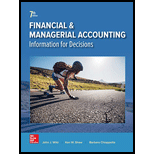
1.
To compute: Annual expected net
1.
Explanation of Solution
Given below is the table for the computation of annual expected net cash flows:
| Annual cash flow | ||
| Particulars | Project Y ($) | Project Z ($) |
| Profit after tax | 56,000 | 36,400 |
| 87,500 | 116,666.66 | |
| Cash flows after tax | 143,500 | 153,066.66 |
Working notes:
Calculation of annual depreciation of Project Y,
Calculation of annual depreciation of Project Z,
Hence, cash flow after tax is from project Y is $143,500 and Project Z is $153,066.67
2.
To compute: Payback period.
2.
Explanation of Solution
Computation of payback period for project Y:
Given,
Cost of investment of Project Y is $350,000.
Annual net cash flow from Project Y is $143,500.
Formula to calculate payback period,
Substitute $350,000 for initial investment and $143,500 for net annual
Computation of payback period for project Z:
Given,
Cost of investment of Project Z is $280,000.
Annual net cash flow from Project Z is $153,066.66.
Formula to calculate payback period,
Substitute $280,000 for initial investment and $153,066.66 for net annual cash inflow.
Hence, payback period of project Y is 2.44 years and Project Z is 1.83 years.
3.
To compute: Accounting
3.
Explanation of Solution
Computation of accounting rate of return (ARR) for Project Y:
Given,
Average annual profit of Project Y is $56,000.
Average investment in Project Y is $175,000.
Formula to calculate accounting rate of return,
Substitute $56,000 for average annual profit and $175,000 for average investment.
Computation of accounting rate of return (ARR) for Project Z:
Given,
Average annual profit of Project Z is $36,400.
Average investment in Project Z is $140,000.
Formula to calculate of accounting rate of return,
Substitute $56,000 for average annual profit and $175,000 for average investment.
Working notes:
Calculation of average investment of Project Y,
Calculation of average investment of Project Z,
Hence, ARR for Project Y is 32% and Project Z is 26%.
4.
To compute:
4.
Explanation of Solution
Computation of net present value (NPV) for Project Y:
Given,
Annual net cash flows from Project Y is $143,500
Cost of investment is $350,000.
Market interest rate is 8%.
Number of periods is 4 years.
Present value factor for cumulative 4 years is 3.31.
Formula to calculate NPV,
Substitute $457,290.20 for the present value of cash flows and $350,000 for the cost of investment.
Computation of Net present value (NPV) for Project Z:
Given,
Annual net cash flow from Project Z is $153,066.66.
Cost of investment is $280,000.
Market interest rate is 8%.
Number of periods is 3 years.
Present value factor for cumulative 3 years is 2.58.
Formula to calculate NPV,
Substitute $394,467.63 for the present value of cash flows and $280,000 for the cost of investment.
Working notes:
Calculation of present value of cash flows of Project Y,
Calculation of present value of cash flows of Project Z,
Hence, NPV for project Y is $125,290.20 and Project Z is $114,467.63.
5.
To identify: Recommendation to management to pursue Project Y.
5.
Explanation of Solution
ul
Hence, it is recommended to management to pursue Project Y.
Want to see more full solutions like this?
Chapter 24 Solutions
Financial and Managerial Accounting
- Accounting 12 May I please have a brief summary highlighting one unique feature of the app, recommending it to Sadie—who wants to use some apps for her dog grooming salon to schedule grooming appointments? Thank you so much,arrow_forwardGiven solution for General accounting question not use aiarrow_forwardKindly help me with this General accounting questions not use chart gpt please fast given solutionarrow_forward
- Please given correct answer for General accounting question I need step by step explanationarrow_forwardQuiksilver Company sold 4,480 units in October at a price of $63 per unit. The variable cost is $51 per unit. Calculate the total contribution margin. A. $62,060 B. $73,080 C. $56,000 D. $99,750 E. $ 53,760 helparrow_forwardI want to this question answer for General accounting question not need ai solutionarrow_forward

 AccountingAccountingISBN:9781337272094Author:WARREN, Carl S., Reeve, James M., Duchac, Jonathan E.Publisher:Cengage Learning,
AccountingAccountingISBN:9781337272094Author:WARREN, Carl S., Reeve, James M., Duchac, Jonathan E.Publisher:Cengage Learning, Accounting Information SystemsAccountingISBN:9781337619202Author:Hall, James A.Publisher:Cengage Learning,
Accounting Information SystemsAccountingISBN:9781337619202Author:Hall, James A.Publisher:Cengage Learning, Horngren's Cost Accounting: A Managerial Emphasis...AccountingISBN:9780134475585Author:Srikant M. Datar, Madhav V. RajanPublisher:PEARSON
Horngren's Cost Accounting: A Managerial Emphasis...AccountingISBN:9780134475585Author:Srikant M. Datar, Madhav V. RajanPublisher:PEARSON Intermediate AccountingAccountingISBN:9781259722660Author:J. David Spiceland, Mark W. Nelson, Wayne M ThomasPublisher:McGraw-Hill Education
Intermediate AccountingAccountingISBN:9781259722660Author:J. David Spiceland, Mark W. Nelson, Wayne M ThomasPublisher:McGraw-Hill Education Financial and Managerial AccountingAccountingISBN:9781259726705Author:John J Wild, Ken W. Shaw, Barbara Chiappetta Fundamental Accounting PrinciplesPublisher:McGraw-Hill Education
Financial and Managerial AccountingAccountingISBN:9781259726705Author:John J Wild, Ken W. Shaw, Barbara Chiappetta Fundamental Accounting PrinciplesPublisher:McGraw-Hill Education





